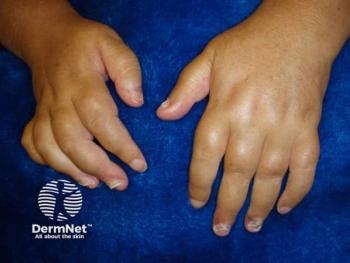
Practice gaps in psoriatic arthritis
Many tools and strategies can help dermatologists overcome their discomfort in addressing psoriatic arthritis (PsA) in patients with psoriasis, physicians report.
Many tools and strategies can help dermatologists overcome their discomfort in addressing psoriatic arthritis (PsA) in patients with psoriasis, according to a report from the Interdisciplinary Autoimmune Summit in April 2017. Such tools include validated patient questionnaires, online resources and partnerships with local and regional rheumatologists.
Screening gaps
"One of the biggest unmet needs we've come across is dermatologists' screening for psoriatic arthritis. Data suggest it's not done nearly as frequently as it should be, and that we're probably missing a lot of psoriatic arthritis," said Joseph F. Merola, M.D., MMSc, of Harvard Medical School's Department of Dermatology and Division of Rheumatology.
A 949-patient study published in the November 2013 Journal of the American Academy of Dermatology showed that 41% of patients with psoriasis referred to rheumatology had undiagnosed PsA. Early diagnosis is important, he said, because another study suggests that a delay in diagnosis as short as six months can lead to more functional disability and worse outcomes. This study appeared in the February 2014 issue of Annals of the Rheumatic Diseases.
To avoid delays in diagnosis and treatment, the Psoriasis & Psoriatic Arthritis Clinics Multicenter Advancement Network (PPACMAN) recommends that all patients with psoriasis are screened for PsA, and that physicians are aware of the features that put patients at higher risk of developing PsA. These include presence of scalp disease, nail involvement or inverse (intertriginous) psoriasis.
For dermatologists uncomfortable with the musculoskeletal history, Dr. Merola demonstrated use of a validated screening questionnaire with an actual patient. In daily practice, a front-desk employee, nurse or physician extender can give patients questionnaires to complete while they're in a waiting room or awaiting the doctor in an exam room. "It takes just a few minutes to complete, and if it's positive, consider referring to a rheumatologist for appropriate management."
Diagnostic gaps
Along with the musculoskeletal history, he said, many dermatologists aren't familiar or comfortable with the musculoskeletal exam, workup and functional diagnosis for PsA. To help dermatologists in these areas, PPACMAN encourages and supports development of combined dermatology-rheumatology clinic models, with dermatologists and rheumatologists working in the same location simultaneously.
"One of our goals is to support local and regional dermatology-rheumatology partnerships -encouraging dermatologists to partner with someone in their community who is familiar with and enjoys treating psoriatic arthritis." Such experts can facilitate screening appointments and communication between both specialties. "We've developed electronic medical record templates that can be shared between providers to facilitate care discussions," said Dr. Merola. The key is communicating and avoiding duplication of efforts.
Additionally, Dr. Merola co-authored a mnemonic to remind dermatologists of the features of inflammatory arthritis, and when to consider using a validated screening tool or referring to rheumatology. The mnemonic appeared in the May 2015 Journal of the American Academy of Dermatology.
Treatment gaps
PPACMAN also encourages regular joint academic conferences (face-to-face or virtual) where physicians can discuss difficult cases. Such arrangements can help build partnerships that support specialists’ learning together and cooperating to treat the whole patient, he said.
"Many dermatologists aren't necessarily comfortable with all of what we consider to be the domains of psoriatic disease." Dermatologists' expertise with skin and nails notwithstanding, they may be less familiar with PsA - especially treatments for axial (spinal) disease - as well as peripheral arthritis, enthesitis (inflammation at tendon insertions into bone) and dactylitis (swollen digits).
With many new systemic therapies available for PsA, he said, knowing when to use which one, how they are dosed and how to approach monitoring, vaccination and the many comorbidities that come with psoriatic disease are critical.
"Dermatologists certainly could become more comfortable with the musculoskeletal exam and psoriatic arthritis exam." This way, they could not only make the diagnosis, but also track how patients' skin and joints are responding to systemic or biologic treatment over time, by using tools such as the Psoriatic Arthritis Impact of Disease (PSAID) questionnaire.
For prescribers of biologics in particular, Dr. Merola said he sees significant pushback from payers and insurance companies, and a heavy burden on practices to deal with prior authorizations (PAs) and the paperwork and phone calls that come with treating patients with psoriasis and PsA appropriately. "Implementing systems to help support that workload can make the physician's life a lot easier."
Potential solutions include dedicating a specific employee to handle insurance and PA requirements, perhaps with support services from the National Psoriasis Foundation (NPF). The NPF provides everything from appeal-letter templates to a Medicaid Advocacy Guide. The NPF also connects patients with mentors to help them navigate the complexities of life with psoriasis.
With the Centers for Medicare and Medicaid Services pushing physicians toward quality-based reimbursement, added Dr. Merola, PPACMAN has partnered with groups including the American Academy of Dermatology and International Dermatology Outcome Measures (IDEOM) to advocate for incentivizing outcomes that matter to patients. "For example, asking 'How many of your patients with psoriasis have you screened for psoriatic arthritis' could be a meaningful incentive for physicians that really impacts patient care, as opposed to some of the things we do now that don't necessarily impact outcomes."
DISCLOSURES
Dr. Merola is a consultant and/or investigator for AbbVie, Amgen, Biogen IDEC, Eli Lilly, Novartis, Pfizer, Janssen, UCB, Samumed, Science 37, Celgene, Merck and GSK.
REFERENCE
Joseph F Merola, MD, MMSc. "Clinical Assessment of PsO/PsA Patient Demonstration," Interdisciplinary Autoimmune Summit. April 29, 2018.
Newsletter
Like what you’re reading? Subscribe to Dermatology Times for weekly updates on therapies, innovations, and real-world practice tips.

















